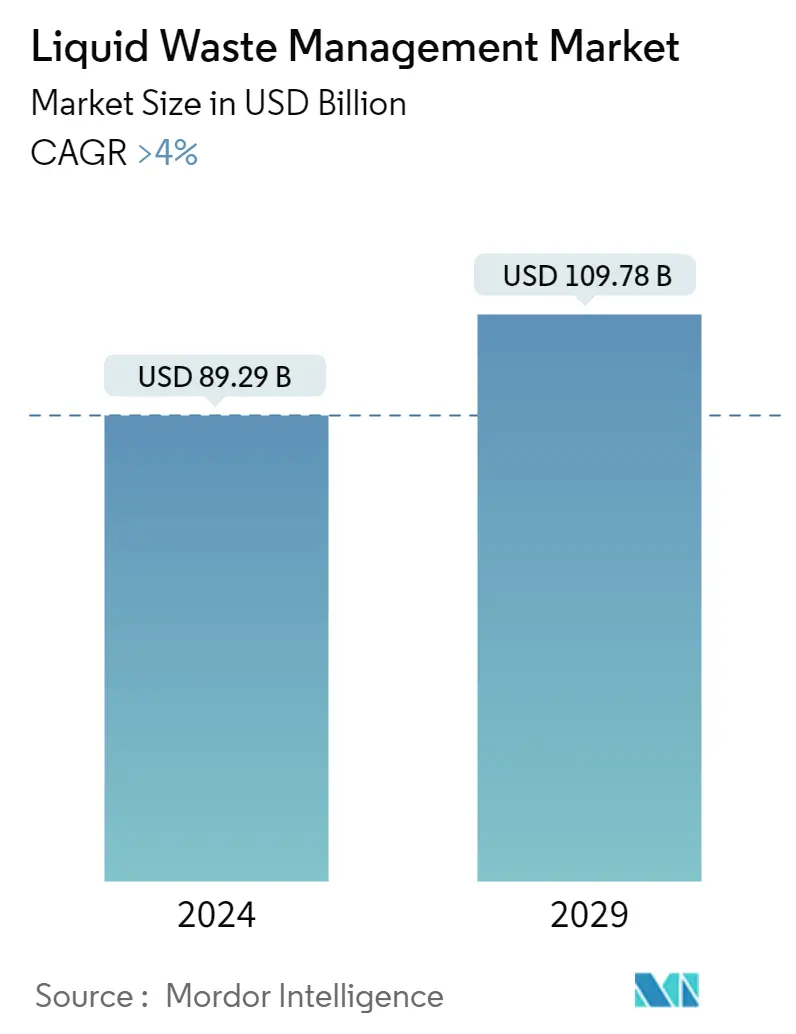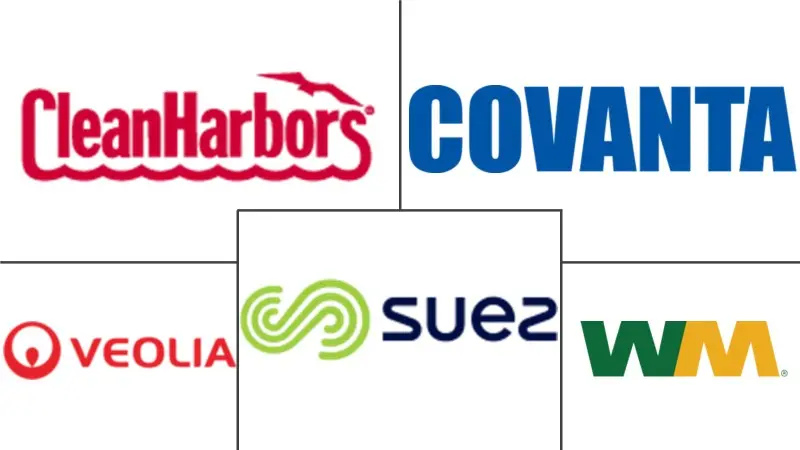Market Size of Liquid Waste Management Industry

| Study Period | 2019-2029 |
| Market Size (2024) | USD 89.29 Billion |
| Market Size (2029) | USD 109.78 Billion |
| CAGR (2024 - 2029) | 4.00 % |
| Fastest Growing Market | North America |
| Largest Market | North America |
Major Players
*Disclaimer: Major Players sorted in no particular order |
Liquid Waste Management Market Analysis
The Liquid Waste Management Market size is estimated at USD 89.29 billion in 2024, and is expected to reach USD 109.78 billion by 2029, growing at a CAGR of greater than 4% during the forecast period (2024-2029).
- The COVID-19 pandemic negatively impacted the market as petroleum refinery units cut their production throughput, and the demand for fuel decreased by about 30% to 40% globally during the lockdown. However, the demand for various pharmaceutical products increased during the pandemic, thereby enhancing the production of liquid wastes. Currently, the market has recovered from the pandemic. The market reached pre-pandemic levels in 2022 and is expected to grow steadily in the future.
- The increasing manufacturing activities that generate toxic chemicals are anticipated to enhance liquid effluent management activities. Also, the growth in the pharmaceutical and healthcare industry is expected to drive the market's growth.
- On the flip side, increasing technological challenges and stringent waste processing regulations are expected to hinder the market’s growth.
- Further, the increasing focus on treating emerging contaminates is likely to provide opportunities to the market studied.
- The North American region represents the largest market, and it is also expected to be the fastest-growing market over the forecast period due to the enactment of stringent norms pertaining to the management of liquid waste and the presence of activities related to oil and gas production.
Liquid Waste Management Industry Segmentation
Liquid waste management is the procedure and practice to prevent the discharge of pollutants, toxic chemicals, and other hazardous liquid byproducts to water bodies or drainage systems. Liquid waste contamination is highly important as liquid waste adversely affects humans and animals by contaminating water, soil, or the air. Therefore, proper handling is highly essential to reduce the spread of diseases, the risk of ruining crops, etc.
The liquid waste management market is segmented by source, service, end-user industry, and geography. By source, the market is segmented into residential, commercial, and industrial. By service, the market is segmented into collection, transportation/hauling, and disposal/recycling. By end-user industry, the market is segmented into automotive, iron and steel, oil and gas, pharmaceutical, textile, and other end-user industries (paper and pulp, food and beverages, etc.). The report also covers the market size and forecasts for the market in 15 countries across the globe.
For each segment, the market sizing and forecasts have been done on the basis of value (USD).
| Source | |
| Residential | |
| Commercial | |
| Industrial |
| Service | |
| Collection | |
| Transportation/Hauling | |
| Disposal/Recycling |
| End-user Industry | |
| Automotive | |
| Iron and Steel | |
| Oil and Gas | |
| Pharmaceutical | |
| Textile | |
| Other End-user Industries (Pulp and Paper, Food and Beverages, etc.) |
| Geography | |||||||
| |||||||
| |||||||
| |||||||
| |||||||
|
Liquid Waste Management Market Size Summary
The liquid waste management market is poised for steady growth, driven by increasing manufacturing activities and the expansion of the pharmaceutical and healthcare sectors. The market has rebounded from the setbacks caused by the COVID-19 pandemic, which had initially led to a decline in demand due to reduced petroleum refinery production. However, the rise in pharmaceutical production during the pandemic contributed to an increase in liquid waste generation. The market is now operating at pre-pandemic levels and is expected to continue its upward trajectory. Despite challenges such as technological hurdles and stringent regulations, the focus on treating emerging contaminants presents new opportunities for market expansion. North America is the largest and fastest-growing region, attributed to strict liquid waste management norms and robust oil and gas production activities.
The oil and gas industry significantly influences the liquid waste management market due to its high water consumption and wastewater generation during operations like hydrostatic testing and hydraulic fracturing. The industry's environmental concerns regarding wastewater disposal necessitate effective liquid waste management solutions. Additionally, the automotive sector contributes to liquid waste production, with used motor oil and brake fluid being notable examples. Regulatory frameworks, such as those enforced by the Environmental Protection Agency and REACH, govern the market, ensuring compliance with environmental standards. Major players like SUEZ, Veolia, and CLEAN HARBORS are actively shaping the market landscape through strategic acquisitions and investments, further solidifying the market's consolidated nature.
Liquid Waste Management Market Size - Table of Contents
-
1. MARKET DYNAMICS
-
1.1 Drivers
-
1.1.1 Growth in the Pharmaceutical and Healthcare Industry
-
1.1.2 Increased Manufacturing Activities Containing Toxic Chemicals Leading to Growing Liquid Effluent Management
-
1.1.3 Other Drivers
-
-
1.2 Restraints
-
1.2.1 Increasing Technological Challenges
-
1.2.2 Stringent Waste Processing Regulations
-
1.2.3 Other Restraints
-
-
1.3 Industry Value Chain Analysis
-
1.4 Porter's Five Forces Analysis
-
1.4.1 Bargaining Power of Suppliers
-
1.4.2 Bargaining Power of Buyers
-
1.4.3 Threat of New Entrants
-
1.4.4 Threat of Substitute Products and Services
-
1.4.5 Degree of Competition
-
-
-
2. MARKET SEGMENTATION (Market Size in Value)
-
2.1 Source
-
2.1.1 Residential
-
2.1.2 Commercial
-
2.1.3 Industrial
-
-
2.2 Service
-
2.2.1 Collection
-
2.2.2 Transportation/Hauling
-
2.2.3 Disposal/Recycling
-
-
2.3 End-user Industry
-
2.3.1 Automotive
-
2.3.2 Iron and Steel
-
2.3.3 Oil and Gas
-
2.3.4 Pharmaceutical
-
2.3.5 Textile
-
2.3.6 Other End-user Industries (Pulp and Paper, Food and Beverages, etc.)
-
-
2.4 Geography
-
2.4.1 Asia-Pacific
-
2.4.1.1 China
-
2.4.1.2 India
-
2.4.1.3 Japan
-
2.4.1.4 South Korea
-
2.4.1.5 Rest of Asia-Pacific
-
-
2.4.2 North America
-
2.4.2.1 United States
-
2.4.2.2 Canada
-
2.4.2.3 Mexico
-
-
2.4.3 Europe
-
2.4.3.1 Germany
-
2.4.3.2 United Kingdom
-
2.4.3.3 France
-
2.4.3.4 Italy
-
2.4.3.5 Rest of Europe
-
-
2.4.4 South America
-
2.4.4.1 Brazil
-
2.4.4.2 Argentina
-
2.4.4.3 Rest of South America
-
-
2.4.5 Middle-East and Africa
-
2.4.5.1 Saudi Arabia
-
2.4.5.2 South Africa
-
2.4.5.3 Rest of Middle-East and Africa
-
-
-
Liquid Waste Management Market Size FAQs
How big is the Liquid Waste Management Market?
The Liquid Waste Management Market size is expected to reach USD 89.29 billion in 2024 and grow at a CAGR of greater than 4% to reach USD 109.78 billion by 2029.
What is the current Liquid Waste Management Market size?
In 2024, the Liquid Waste Management Market size is expected to reach USD 89.29 billion.

